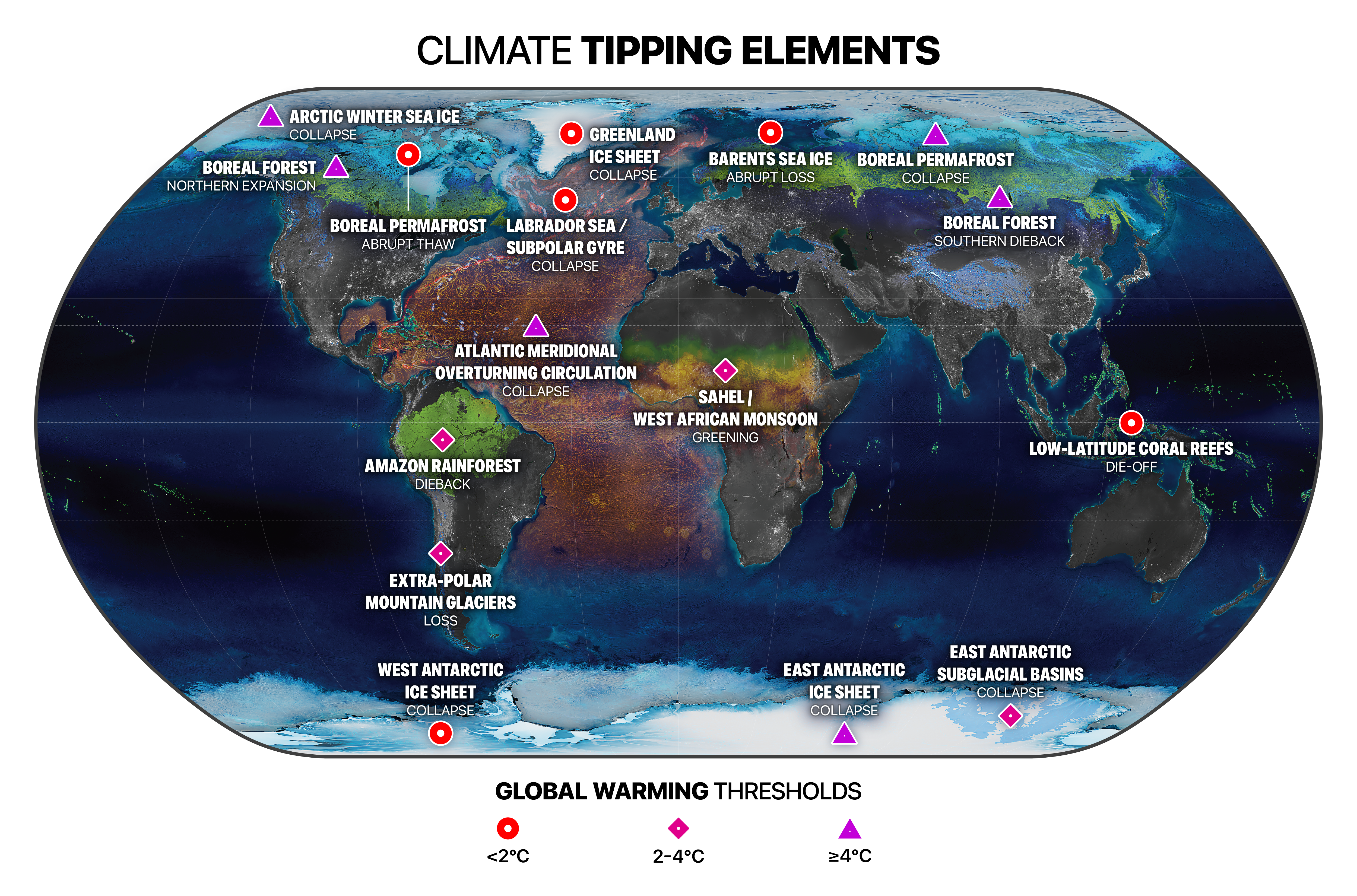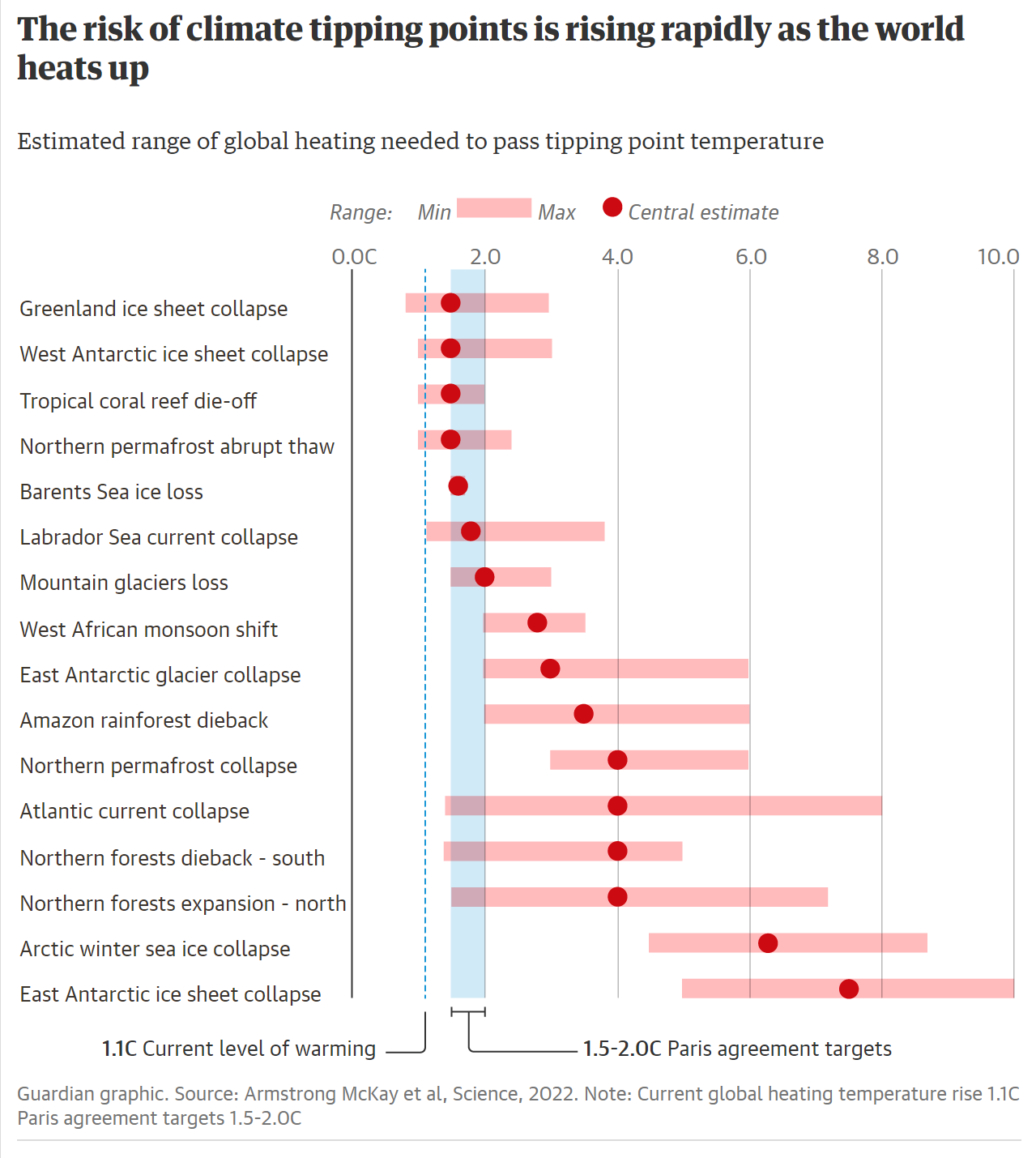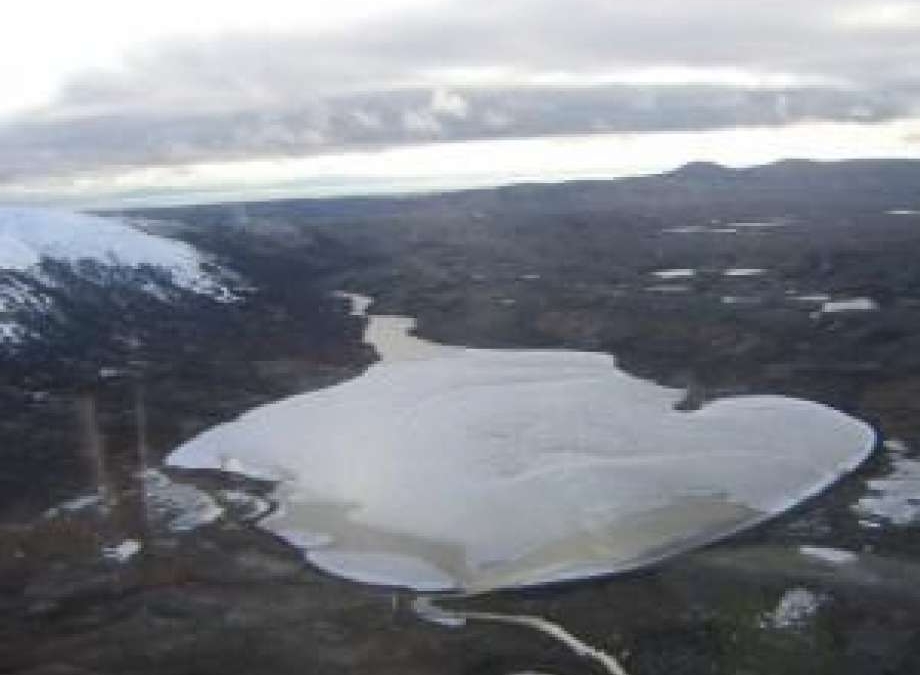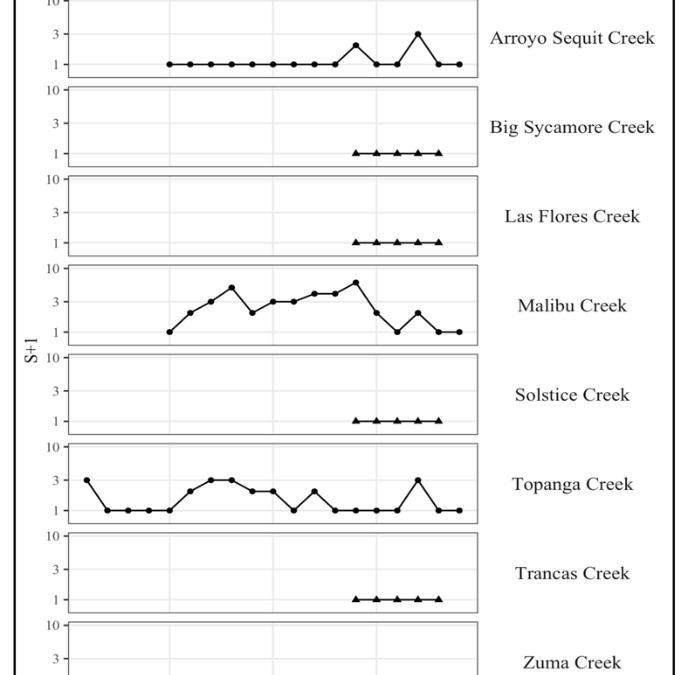World at risk of passing multiple climate tipping points above 1.5°C global warming

8 September 2022 (Stockholm Resilience Centre) – Multiple climate tipping points could be triggered if global temperature rises beyond 1.5°C above pre-industrial levels, according to a major new analysis published in the journal Science.
Even at current levels of global heating the world is already at risk of passing five dangerous climate tipping points, and risks increase with each tenth of a degree of further warming.
An international research team synthesised evidence for tipping points, their temperature thresholds, timescales, and impacts from a comprehensive review of over 200 papers published since 2008, when climate tipping points were first rigorously defined. They have increased the list of potential tipping points from nine to sixteen.
The research concludes human emissions have already pushed Earth into the tipping points danger zone.
Five of the sixteen may be triggered at today’s temperatures:
- The Greenland ice sheets
- West Antarctic ice sheets
- Widespread abrupt permafrost thaw
- Collapse of convection in the Labrador Sea
- Massive die-off of tropical coral reefs
Four of these move from possible events to likely at 1.5°C global warming, with five more becoming possible around this level of heating.
The world is already at risk of some tipping points. As global temperatures rise further, more tipping points become possible.
David Armstrong McKay, lead author
Already left safe climate
The Sixth Assessment Report of the Intergovernmental Panel on Climate Change (IPCC), stated that risks of triggering climate tipping points become high by around 2°C above preindustrial temperatures and very high by 2.5-4°C.
This new analysis indicates that Earth may have already left a ‘safe’ climate state when temperatures exceeded approximately 1°C warming. A conclusion of the research is therefore that even the United Nations’ Paris Agreement goal to limit warming to well-below 2°C and preferably 1.5°C is not enough to fully avoid dangerous climate change.
According to the assessment, tipping point likelihood increases markedly in the ‘Paris range’ of 1.5-2°C warming, with even higher risks beyond 2°C.
The study provides strong scientific support for the Paris Agreement and associated efforts to limit global warming to 1.5°C, because it shows that the risk of tipping points escalates beyond this level.
To have a 50% chance of achieving 1.5°C and thus limiting tipping point risks, global greenhouse gas emissions must be cut by half by 2030, reaching net-zero by 2050.
New tipping elements
The researchers categorised the tipping elements into nine systems that affect the entire Earth system, such as Antarctica and the Amazon rainforest, and a further seven systems that if tipped would have profound regional consequences. The latter include the West African monsoon and the death of most coral reefs around the equator.
Several new tipping elements such as Labrador Sea convection and East Antarctic subglacial basins have been added compared to the 2008 assessment, while Arctic summer sea ice and the El Niño Southern Oscillation (ENSO) have been removed for lack of evidence of tipping dynamics.
Updating global risks
Co-author Ricarda Winkelmann, a researcher at the Potsdam Institute for Climate Impact Research and a member of the Earth Commission says, “Importantly, many tipping elements in the Earth system are interlinked, making cascading tipping points a serious additional concern. In fact, interactions can lower the critical temperature thresholds beyond which individual tipping elements begin destabilising in the long-run.”
Armstrong McKay says, “We have made a first step towards updating the world on tipping point risks. There is an urgent need for a deeper international analysis, especially on tipping element interactions, towards which the Earth Commission is starting a Tipping Points Model Intercomparison Project (“TIPMIP”).”
Contact
- David Armstrong McKay, d.mckay@exeter.ac.uk, +44 7950468908 (Brighton, GMT); Tim Lenton, t.m.lenton@exeter.ac.uk
- Stockholm Resilience Centre: Owen Gaffney, Owen.Gaffney@su.se, +46 734604833 (Stockholm, GMT+1)
- Earth Commission: Maya Rebermark, maya.rebermark@futureearth.org, +46 73 821 68 87 (Stockholm, GMT+1); Bridget Blake bridget.blake@futureearth.org, +1 480-242-1757 (Atlanta, GMT-4)
- Exeter University: Alex Morrison A.Morrison@exeter.ac.uk/pressoffice@exeter.ac.uk, +44 7920 278762 (Exeter, GMT)
- Potsdam Institute: presse@pik-potsdam.de, +49 331 288 25 07 (Potsdam, GMT+1)
World at risk of passing multiple climate tipping points above 1.5°C global warming

Exceeding 1.5°C global warming could trigger multiple climate tipping points
ABSTRACT: Climate tipping points (CTPs) are a source of growing scientific, policy, and public concern. They occur when change in large parts of the climate system—known as tipping elements—become self-perpetuating beyond a warming threshold. Triggering CTPs leads to significant, policy-relevant impacts, including substantial sea level rise from collapsing ice sheets, dieback of biodiverse biomes such as the Amazon rainforest or warm-water corals, and carbon release from thawing permafrost. Nine policy-relevant tipping elements and their CTPs were originally identified by Lenton et al. (2008). We carry out the first comprehensive reassessment of all suggested tipping elements, their CTPs, and the timescales and impacts of tipping. We also highlight steps to further improve understanding of CTPs, including an expert elicitation, a model intercomparison project, and early warning systems leveraging deep learning and remotely sensed data.
RATIONALE
Since the original identification of tipping elements there have been substantial advances in scientific understanding from paleoclimate, observational, and model-based studies. Additional tipping elements have been proposed (e.g., parts of the East Antarctic ice sheet) and the status of others (e.g., Arctic summer sea ice) has been questioned. Observations have revealed that parts of the West Antarctic ice sheet may have already passed a tipping point. Potential early warning signals of the Greenland ice sheet, Atlantic Meridional Overturning Circulation, and Amazon rainforest destabilization have been detected. Multiple abrupt shifts have been found in climate models. Recent work has suggested that up to 15 tipping elements are now active (Lenton et al., 2019). Hence it is timely to synthesize this new knowledge to provide a revised shortlist of potential tipping elements and their CTP thresholds.
RESULTS
We identify nine global “core” tipping elements which contribute substantially to Earth system functioning and seven regional “impact” tipping elements which contribute substantially to human welfare or have great value as unique features of the Earth system (see figure). Their estimated CTP thresholds have significant implications for climate policy: Current global warming of ~1.1°C above pre-industrial already lies within the lower end of five CTP uncertainty ranges. Six CTPs become likely (with a further four possible) within the Paris Agreement range of 1.5 to <2°C warming, including collapse of the Greenland and West Antarctic ice sheets, die-off of low-latitude coral reefs, and widespread abrupt permafrost thaw. An additional CTP becomes likely and another three possible at the ~2.6°C of warming expected under current policies.
CONCLUSION
Our assessment provides strong scientific evidence for urgent action to mitigate climate change. We show that even the Paris Agreement goal of limiting warming to well below 2°C and preferably 1.5°C is not safe as 1.5°C and above risks crossing multiple tipping points. Crossing these CTPs can generate positive feedbacks that increase the likelihood of crossing other CTPs. Currently the world is heading toward ~2 to 3°C of global warming; at best, if all net-zero pledges and nationally determined contributions are implemented it could reach just below 2°C. This would lower tipping point risks somewhat but would still be dangerous as it could trigger multiple climate tipping points.
Exceeding 1.5°C global warming could trigger multiple climate tipping points



Many thanks for this service to our community!
You are most welcome!
We do not know exactly in which order, and their addition may have unexpected consequences, but we are passing climate tipping points. We are not speaking about a risk but about facts that we are documenting. The only risk there is lies in not doing anything to alter the course we have steadily followed toward our own extinction. Many thanks ro Desdemona Despair for informing our community!